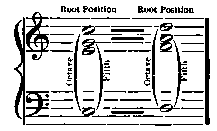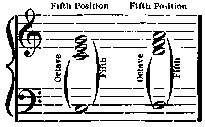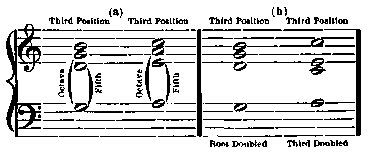Harmony Book For Beginners - online book
Scales, Intervals, Common Chords, Dominant Seventh Chord and Melody Making.
| Share page | Visit Us On FB |
|
106 |
OREM'S HARMONY BOOK |
||
|
CHAPTER XXV
FREER USE OF CHORDS AND INVERSIONS
So far we have withheld from the student the prohibition found in all harmony-books: avoid parallel or consecutive fifths or octaves between any two parts or voices. Modern composers pay little, if any, attention to this prohibition, so far as free instrumental writing is concerned; but in pure four part harmony, especially for practice, it should be strictly obeyed: Up to this point, by sticking to the principle that no two Chords he written in succession in the same Position, the student has avoided the bugbear of consecutive Fifths and Octaves. Let us illustrate: |
|||
|
|
|||
 |
|||
|
Here are Consecutive Octaves between the upper and lower parts in these two Chords: C-C and D-D; also, Consecutive Fifths between the Bass part and the next to the upper part: C-G and D-A. By writing the Chords in different Positions these would be avoided. Here is another example: |
|||
 |
|||
|
The remedy is the same. Change the Position of one of the Chords.
As two Octave Positions in succession, or two Fifth Positions in succession are rarely satisfactory, the student will not wish to use them anyway.
It is convenient at times to write two Third Positions in succession. If the Third of one of these Chords be doubled instead of the Root, Consecutive Fifths and Octaves will be avoided. This is not so difficult as it sounds. Let us illustrate: |
|||
|
|
|||
 |
|||